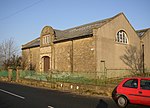St Peter's Church, Quernmore
19th-century Church of England church buildingsChurch buildings by E. G. PaleyChurch of England church buildings in LancashireChurches completed in 1860Churches in the City of Lancaster ... and 5 more
Diocese of BlackburnGothic Revival architecture in LancashireGothic Revival church buildings in EnglandGrade II listed churches in LancashireUse British English from September 2013

St Peter's Church is in the village of Quernmore, Lancashire, England. It is an active Anglican parish church in the deanery of Lancaster and Morecambe, the archdeaconry of Lancaster, and the diocese of Blackburn. Its benefice is united with those of St Mark, Dolphinholme, and Christ Church, Over Wyresdale. The church is recorded in the National Heritage List for England as a designated Grade II listed building. It stands in a relatively isolated position about 1 mile (1.6 km) to the north of the village and 2.5 miles (4.0 km) to the east of the city of Lancaster.
Excerpt from the Wikipedia article St Peter's Church, Quernmore (License: CC BY-SA 3.0, Authors, Images).St Peter's Church, Quernmore
Postern Gate Road, Lancaster
Geographical coordinates (GPS) Address Website External links Nearby Places Show on map
Geographical coordinates (GPS)
| Latitude | Longitude |
|---|---|
| N 54.0366 ° | E -2.7377 ° |
Address
St. Peter
Postern Gate Road
LA2 9EL Lancaster
England, United Kingdom
Open on Google Maps








